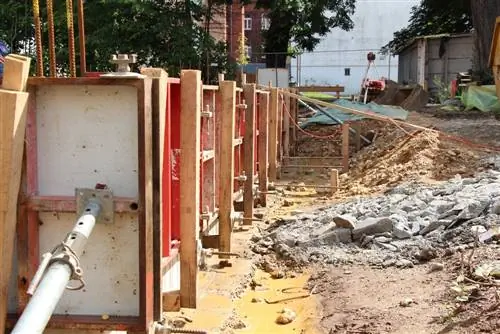- Author admin [email protected].
- Public 2023-12-17 03:39.
- Last modified 2025-06-01 06:48.
Builders are often restricted in the realization of their dream home by building regulations for a plot of land, which in turn can be to the disadvantage of building land sellers. Compliance with legally prescribed minimum distances to neighboring properties or compliance with maximum building area depending on the area of the property are just two possible examples of problems. Under certain conditions, a unification building load for neighboring properties can be the solution.
Association building load - definition
As the term suggests, it is primarily a type of union of two or more properties. In order for these to be “united”, they must be neighboring properties. A unification building burden involves treating two or more neighboring properties as one property in building law. A joint building burden generally requires a building law reason.
With the unification building burden, for example, property boundaries between the neighboring properties involved are eliminated. The association building load always includes at least one so-called “serving property”. This or the property owner has a public law obligation to the responsible building authority to dissolve their property boundary to a neighboring property. This means that the neighboring property becomes the so-called “dominant” part and the neighboring boundary does not have to be taken into account when it comes to building law issues.
Ownership relationships in the case of unification building load
The ownership structure of the individual properties is not affected by an association building burden. This means that each participating property owner retains his ownership rights to his property to the extent that it was/is registered in the land registry before an association building charge. An association building burden is not entered in the land register. There will also be no change in the area of taxes.
Use of association building burdens
Example 1
Mr. Meier owns a two-family house on his property in which the apartments are located next to each other and each has its own entrance. One side is now to be sold including the property on the side. A property division makes this theoretically possible. But because the house is not in the middle of the property, its portion of the property would be significantly smaller.
The building law states that the built-up area of his half of the house is too large for the size of the property remaining. A division of the property would therefore not be possible in this case. However, if a unification building burden is applied for and approved at the same time as the property is divided, the property continues to be considered as one for building regulations even after the division. As the property owner, the house buyer regularly receives the land register entry.
Example 2
Mrs. Schmidt's son can buy the property next door to his mother's cheaply. In order to be able to realize his dream house plan, he would have to build close to the property line to his mother's property. This has no objections, but the building authority does, since as the builder he is legally obliged to maintain the minimum distance to the property boundaries of adjacent properties. Here his mother can now give the building authority the obligation to apply a joint building burden. In this way, the mother dissolves the boundary between the two properties and the son no longer has to take this into account when building.
Example 3
Two married couples who are friends have bought two pieces of land one behind the other that they would like to build on. There is no access from the street for development to the rear property. This means that the cables can only reach the rear property via the front property. Here the couple could agree on a so-called easement, which legally and permanently stipulates a structural relocation over the first property. In order to save costs, the new property owners decide to combine construction. The two properties become one property in the building law sense. As a result, only the front property needs to be developed. The rear property can now be connected to this.
Application

No binding information can be provided as a general rule regarding the application for an association building burden, as the individual federal states may have different requirements. Accordingly, the following information in some points only serves as a guide. Before submitting an application, it is advisable to obtain precise information about the responsible authority.
Responsibility
A joint building load can be applied for via the responsible building authority or the municipality's building supervisory authority.
Applicant
Any of the property owners involved can submit the application. Whoever submits the application will usually also be the invoice recipient for the fees incurred.
In any case, the property owner whose property is “encumbered” must indicate the readiness for construction with his signature on a separate form. In technical jargon this is referred to as the “construction contractor”. In some cities/countries, after the client submits the application, the building contractor is invited to a personal appointment in order to provide the signature and to be able to authenticate it directly. If the building contractor lives further away, the signature can be made at a building authority near the home and certified there. Alternatively, the signature can also be certified by a notary.
Documents/documents to be submitted
- Completed and signed application form
- Construction load declaration from the building contractor with signature certification
- Current land register extract of all properties involved (must not be older than three months)
- Cadastral extracts of all properties involved
- Site plan in five copies with marking and dimensions of the property area to be burdened
- Depending on the building authority, a separate cost assumption form may be required for the resulting fees
- If it is commercial or association property, commercial or association register extracts must be submitted
Editing process
If all the necessary documents and signatures are available, the building supervisory authority will initiate a so-called building permit process. The processing time can vary greatly depending on the workload and individual cases. On average, a processing time of between four and six weeks can be expected.
If the application is approved, an entry will be made in the building burden register and the association building burden will become legally binding.
Costs
Depending on the municipality, administrative effort, economic value or other building benefits, the costs are usually put together individually. They vary between 60 euros and 500 euros. The fee refund is also due if the building contractor changes his mind after the application has already been submitted and does not sign the building encumbrance declaration. It is possible to request written information about entries in the building burden register. Here again a fee of between 15 euros and 50 euros is due.
Tip:
The result of the building permit procedure will be communicated to the applicant in writing and at least the entry in the building burden register will be communicated to the building authority in writing. This is already binding and the association's building burden is legally binding, so that additional proof from the building burden register is not necessary.
Association building burden in the event of inheritance or sale
If there is a change of ownership of the property through sale or inheritance for which the property association's obligation was entered into, this will remain unaffected and continue to exist. This is to protect the owner of the “dominant” property. This is intended to prevent the neighbor from having to demolish his house or parts of it in the worst case scenario if the obligation were to expire if it was built across the (former) property boundary.
Deletion of an association building burden
If an association building burden is registered on one or more properties, it can be deleted under certain conditions. The following requirements must be met:
- The originally planned construction will not take place (the reason has been eliminated)
- There is no public interest in maintaining an association building burden
- Consent from the responsible building supervisory authority must be given
Influence on property value

Since at least two properties are involved in a joint building load, this usually means that there is a disadvantage for one part and an advantage for the other. The “dominant” property has the advantage, as it benefits from the separation of the property boundary from the neighboring property. The result can be an increase in the value of the property.
The property for which a building burden is registered loses its right to a clear demarcation from the neighboring property. This can potentially reduce the value of a property.
Depending on the individual case and development, a reduction in value does not always occur. It should be taken into account that a unified building load offers more flexibility in development, which would not be possible without this building law agreement. Whether and to what extent which property can be expected to have a reduction in value or an increase in value can be determined using an expert and a corresponding report.






